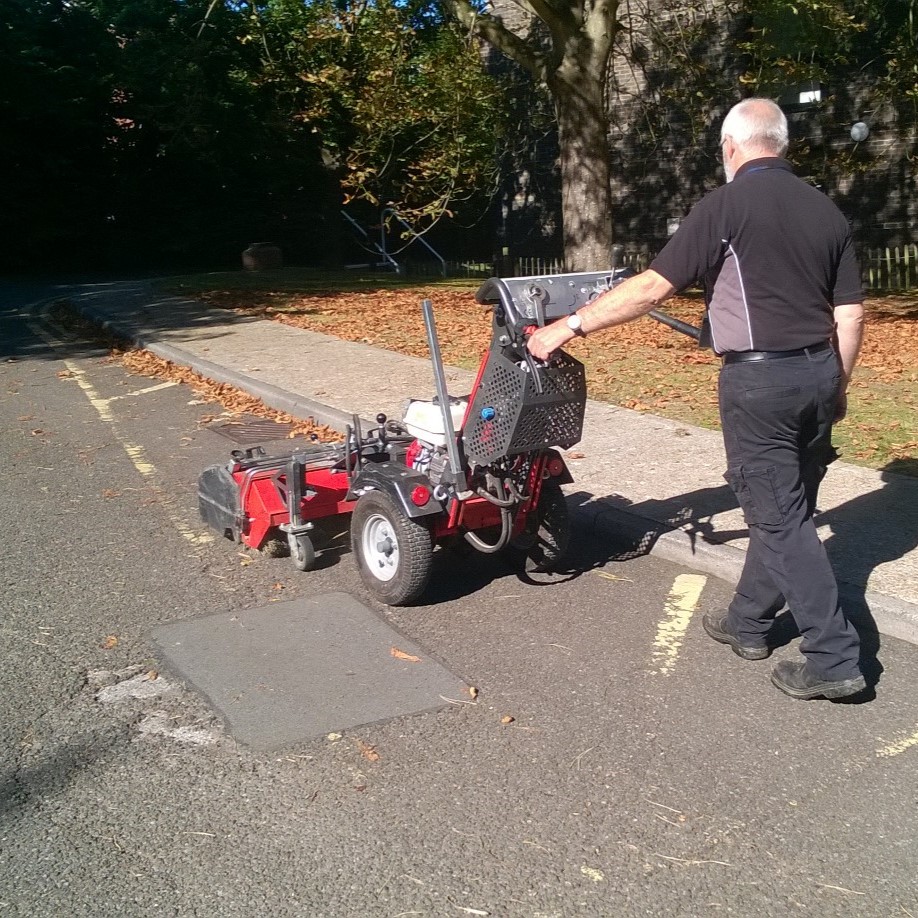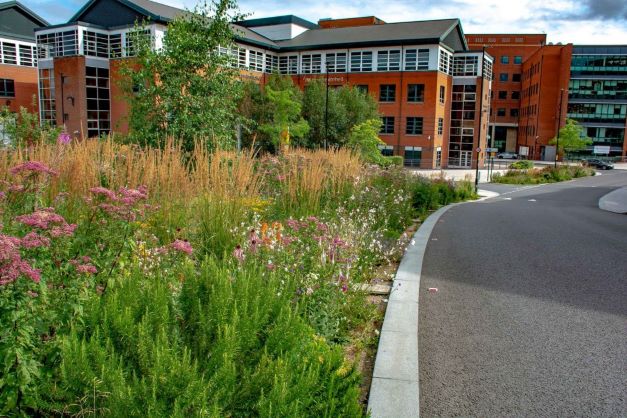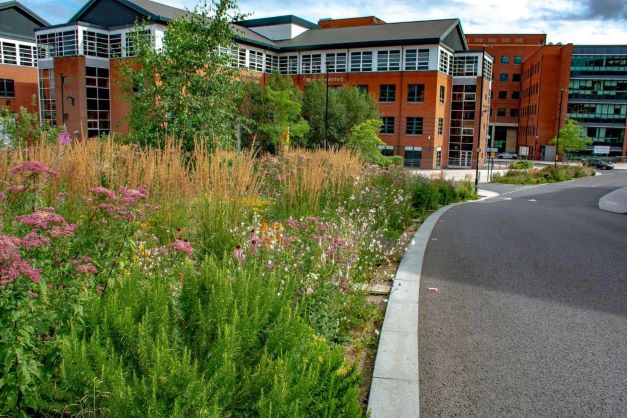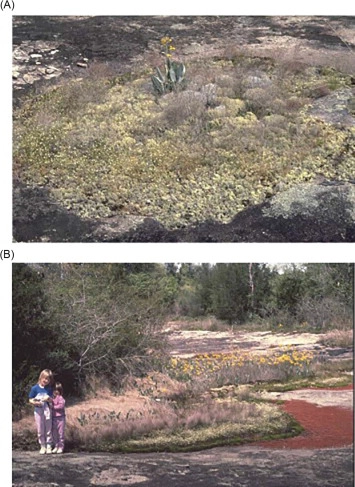Integrated Weed Management
To date - (August 2022) as many as 80 of the 398 principle councils in the UK have now made the decision to phase out their use of glyphosate for killing weeds in public spaces. This is an encouraging sign that Councils are waking up to issues which may be caused by overuse of chemicals.
This page is designed to provide a guide to understanding the basic elements of an integrated weed management strategy, which is achievable, by implementing a series of Nature based Solutions (NbS). These Nature based Solutions require the understanding and cooperation from a wide group of stakeholders. Each group of stakeholders may hold a responsibility for an aspect of the strategy; without whose cooperation the strategy may be compromised. By integrating these nature based solutions and responsibilities, across departments, we can confidently develop a robust strategy, which not only controls weeds but enhances our environment for the benefit and access to all.

WEED PREVENTION
Prevention is the foundation of an Integrated Weed Management Approach. It can have a massive impact on the effectiveness of remedial treatments.
Design
Managing weeds begins with designing out weeds in the environments where they may emerge. We can plan landscapes in a way that reduces weeds by;
• Choosing plants that reduce detritus, such as ground cover rather than grass.
• Choosing surfaces that provide less traps for detritus, such as tarmac rather than block paving
• Use kerbs that are easily swept to; e.g. use sweeping bends, rather than sharp corners; see image to the right, which shows the problems the sharp corners can cause.
• Design hedges and fences to be easily accessed for maintenance.
• Think about and mitigate the impact of surrounding unmanaged vegetation.
Reducing Detritus
Soil on hard surfaces is usually generated by the degradation of detritus. As the detritus from surrounding vegetation is broken down by organisms and natural processes it forms a nutrient rich soil. If we can remove the detritus early, we can use less time intensive operations to remove it.
If we can reduce the amount of detritus that falls on the hard surfaces to begin with, it makes removing it even easier. Things like switching cut and drop grass cutting to cut and collect can make a huge difference. Choosing slower growing plants that require less maintenance is important, but so is simple cutting back of overhanging branches, or putting barriers between hard and soft surfaces to catch detritus that may be blown onto the hard surface.

Acting Early
In order to kill a weed as efficiently as possible, it is essential to kill the plant earlier in its life cycle. Thermal Weed Management techniques will be most effective when used on germinating seeds, and the earlier in the plant life cycle you treat a plant, the less energy it will require to do the job.
Once a plant is fully established, with deep root systems, foliage and flowers, it requires much more energy and many more applications to kill. Killing a plant early will also reduce the seed bank, as the plant will not have generated fresh seeds that can enter detritus and soil to start the growing process all over again. If we can reduce the bank of seeds entering the system, we can greatly reduce the number of weeds we need to deal with next time around.

More information on Weed Prevention
CULTURAL WEED CONTROL
Sometimes in Agriculture - Cultural Weed Control is used to describe things like crop rotation and plant choices. In Amenity, culture is more about the prevailing attitudes and way of doing things. We've set out some important cultural considerations below.
Changing The Contracts
Ensure that your tender and contract wording allows an integrated approach to weed management. If your contract states that "areas are kept clear of weeds through the application of an approved weed control chemical on five separate occasions throughout the year." Then it is not easy for a contractor or your staff to change their approach and adopt an integrated strategy for managing weeds.
IPM is complex and requires a highly individualised approach to meet the specific needs of the surfaces being treated.
Community Involvement
Often residents can be helpfully engaged in community weeding schemes to reduce some of the burden on Council Operatives and Professional Contractors. Many councils such as Manchester and Lambeth council have made progress with this strategy.
Cllr Adilypour said: "The response to the Community Weeding Scheme was amazing and we want to say a big thank you to everyone who has been taking part. By Spring 2021 around 150 streets were participating, contributing to a significant reduction in the amount of glyphosate sprayed in the borough and demonstrating that weeds can be managed without chemicals."

Appointing A Champion
Each element of a carriageway, or other asset may require an individual maintenance regime.
The maintenance responsibility of an asset may fall to more than one party. For example the back line, footway and inner kerb may be the responsibility of one party and the outer kerb and carriageway the responsibility of another. Many stakeholders may have an interest in your Integrated Weed Management Policy. Appointing an Integrated Weed Management Champion, who can liaise across multiple departments is key to allowing an integrated approach to be executed efficiently, making best use of budgets and processes.
MECHANICAL WEED CONTROL
Mechanical Weed Management employs labour saving devices to kill or disrupt plant growth by interfering with one or more of the elements a plant requires for growth. This can include brushes, hot water, foam, hot air, electrocution or chemical methods.
Removing Soil
Soil depth greatly affects the types of weeds that will emerge. Large perennial or woody plants require deeper soil to support their structure and provide nutrients.
Removing soil that has accumulated on hard surfaces is therefore very important for reducing these types of weeds, which can be much harder to kill than annuals and moss.
Removing soil will also allow the hard surfaces to dry out more quickly, as soil retains moisture well. This will greatly reduce the amount of moss, which thrives in damp environments.
Soil can be mechanically removed from hard surfaces with a weed brush and then collected with a sweeper or vacuum

Removing Detritus
Once the sources of detritus have been minimised, there will hopefully be less detritus to deal with. However, it is still likely that lots of detritus is being produced from maintenance operations in summer and from natural processes (such as leaf fall) during the autumn. This detritus will be blown into traps in the hard surfaces such as the gaps in block paving, or the kerb line.
Sweeping or vacuuming this detritus is a good strategy for preventing it degrading into soil, by which point it will be harder to remove. Ensuring that you have the correct equipment to remove detritus on the surfaces you are tackling is key to reducing costs and dealing with different access requirements of particular surfaces.

Thermal Treatment
Having removed the soil from hard suraces over the winter, there will be less opportunities for weeds to grow in the spring. However, you are still likely to get some. Thermal weed control works best on younger plants, so timing treatments for March and April will yield the most successful results and lead to less regrowth.
All thermal methods work by congealing the chloroplast cells, which are mostly found in the leaf and stem. Germinating seeds also contain this. By incapacitating these cells, the plant is prevented from photosynthesizing, effectively starving the plant. Regrowth is possible only if a plant has enough energy stored in the root system to reproduce the foliage. If not the plant will die.

More Information on Mechanical Weed Management
BIOLOGICAL WEED CONTROL
Using nature to tackle weeds is a fundamental piece of the Integrated Weed Management puzzle and Biological control is more than just introducing bio-herbicides.
Natural Processes
Weeds are plants that are growing in the wrong place. The most important thing to understand is why a plant has grown where it has. All plants need water, light and nutrients to grow. If we can disrupt any of these then the plant will not be able to survive. Further understanding of natural processes such as the soil cycle and plant lifecycle allows us to plan preventative and remedial work and time them most effectively. In so doing we can greatly reduce the number of treatments required in a year, the cost of treatments and the carbon required for treatments to take place.
Plant Choices
The right plant in the right place is a great ethos for Integrated Weed Management. Weeds will irrupt into bare soil, whether the soil is meant to be there or not. in soft landscapes, we must ensure that we have chosen a desirable plant to fill any bare soil, or we should expect weeds to take their place. On hard surfaces we should ensure there is no soil to populate.
Choosing appropriate species in order to crowd out weeds, while reducing detritus and maintenance operations as much as possible is key to making weed management a cost effective activity.

Bio-Herbicides
Some things in nature, such as certain fungi and bacteria can act as natural pesticides. More and more interest is emerging in this field, providing solutions from nature to help us eradicate certain types of weed by introducing natural predators.
Bio-herbicides can be selectively used to eradicate certain populations of plant in an area while leaving other plants undamaged. These techniques can be used to effectively supplement the other techniques outlined in this document. Of course it is also possible to integrate synthetic herbicides within this strategy too.
EQUIPMENT SOLUTIONS FROM KERSTEN
Kersten offer a large range of Weed Management Equipment for looking after all sorts of surfaces. The various types of products are laid out below with Pedestrian and Tractor Mounted Versions available to suit different sites.
Sweepers
Kersten sweepers have been designed specifically for effective removal of detritus on hard surfaces. The 5 row spiral brushes are configured to effectively move bulky, heavy material such as soil, allowing your hard surfaces to stay clean and dry out more quickly to prevent moss from taking hold.
Kersten sweepers can all be fitted with collection boxes and gully brushes to make collection of material easy, even right up to a kerb edge.

Weed Brushes
Kersten Weed Brushes are ideal for removing larger amounts of soil and vegetation from hard surfaces. We have brushes to tackle a whole range of jobs, from moss in block paving, right up to path and highway edging, removing large amounts of verge that is encroaching onto the hard surface.
The Kersten Weed Brushes are available with different types of brush to suit different situations. The brush heads can be angled and the height adjusted to provide the best finish.
Thermal Devices
We offer Thermal Weed Management solutions from Ripagreen and Haaf. These machines use hot air to wilt the plant. This hot air instantly causes a thermal shock that breaks the chlorophyll producing part of the plant, the process of photosynthesis is prevented. The plant then dries naturally with a visible result after a few hours.
Hot air is a quick and efficient way to treat young vegetation. The Ripagreen systems use 94% air to 6% gas.

Gravel Path Renovators
Kersten provide a range of gravel path renovators and graders capable of doing a range of tasks including de-compaction, filling in potholes, removing weeds, grading and rolling gravel surfaces.
Some of our machines use special knives for cutting under the plant and lifting it to the surface, other tools rip up and then grade the surface . Essentially re-laying the gravel path to allow better accessibility for vehicles and pedestrians.












